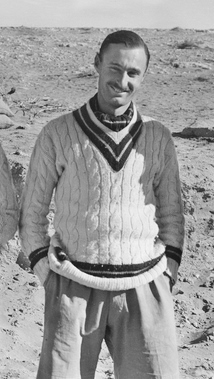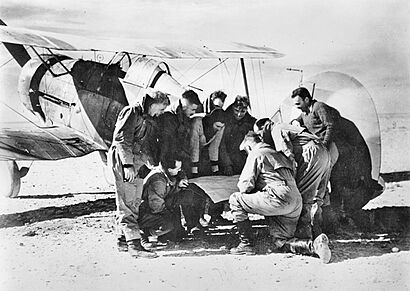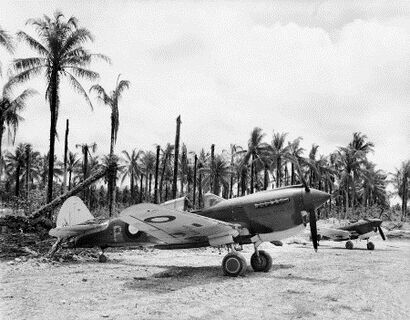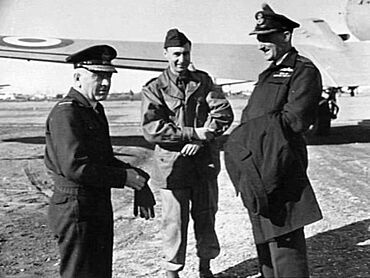Gordon Steege facts for kids
Quick facts for kids
Gordon Steege
|
|
|---|---|

Flight Lieutenant Steege serving with No. 3 Squadron in North Africa, December 1940
|
|
| Born | 31 October 1917 Chatswood, New South Wales |
| Died | 1 September 2013 (aged 95) Palm Beach, New South Wales |
| Allegiance | Australia |
| Service/branch | Royal Australian Air Force |
| Service years | 1937–46 1950–72 |
| Rank | Air Commodore |
| Unit | No. 3 Squadron (1938–39, 1940–41) No. 11 Squadron (1939–40) School of Land/Air Warfare (1952–53) |
| Commands held | No. 450 Squadron (1941–42) No. 14 Mobile Fighter Sector (1943) No. 73 Wing (1943–44) No. 81 Wing (1944) RAAF Station Schofields (1950–51) No. 77 Squadron (1951) RAAF Base Canberra (1957–58) RAAF Base Amberley (1964–67) RAAF Base Butterworth (1967–69) RAAF Base Edinburgh (1969–70) |
| Battles/wars |
|
| Awards | Distinguished Service Order Distinguished Flying Cross Mention in Despatches |
| Other work | Aerospace consultant |
Air Commodore Gordon Henry Steege (born 31 October 1917 – died 1 September 2013) was a very important officer and pilot in the Royal Australian Air Force (RAAF). He became a fighter ace during World War II. This means he shot down at least five enemy aircraft. He was credited with eight aerial victories. He also led groups of planes called squadrons and wings in combat.
Gordon Steege was born in Sydney, Australia. He joined the RAAF in July 1937. He first fought in late 1940 with No. 3 Squadron in the Middle East. There, he flew different types of fighter planes like the Gloster Gladiator, Hawker Hurricane, and P-40 Kittyhawk. He shot down enemy planes using all three types. He received the Distinguished Flying Cross after shooting down three German planes in one flight in February 1941. He later became the leader of No. 450 Squadron. He returned to Australia in December 1942.
After returning to Australia, he led different fighter groups in the South West Pacific. He earned the Distinguished Service Order in April 1944 for his "outstanding leadership." He ended World War II as a group captain.
After World War II, Steege left the RAAF for a short time. He worked in New Guinea. He rejoined the RAAF during the Korean War. He briefly led No. 77 Squadron in late 1951. He found that their Gloster Meteor jets were not as good as the enemy's MiG-15s in air-to-air fights. So, he changed the squadron's role to escorting other planes and defending local areas. This decision was a bit controversial. After the war, he held many important jobs in the RAAF. He commanded several RAAF bases, including RAAF Base Amberley and RAAF Base Butterworth in Malaysia. He became an Air Commodore before retiring in 1972. Later, he worked as an aerospace consultant. He passed away in Sydney in 2013, at ninety-five years old.
Contents
Early Life and Joining the RAAF
Gordon Henry Steege was born in Chatswood, a suburb of Sydney, on 31 October 1917. His parents were William and Ida Steege. He went to North Sydney Boys High School.
Gordon always wanted to have a military career. He tried to join the Royal Australian Navy when he was twelve, but he wasn't successful. He also tried to get into the Royal Military College, Duntroon, but that didn't work out either. Before joining the Air Force, he worked for three years at a company called Perpetual Trustee Company. He was a clerk there.
On 21 July 1937, Gordon Steege joined the Royal Australian Air Force (RAAF). He learned to fly planes like the Avro Cadet and Westland Wapiti at No. 1 Flying Training School in Point Cook, Victoria. He did very well in his training and finished on 23 June 1938. He became a pilot officer. His first job was with No. 3 (Army Cooperation) Squadron at RAAF Station Richmond. He flew Hawker Demon biplane fighters. Gordon and his squadron worked with the Australian Army. They flew missions to scout for information, help artillery units aim, and practice attacking targets on the ground. He was promoted to flying officer in December 1938.
World War II Service
When World War II began in September 1939, Gordon Steege became an adjutant for the new No. 11 Squadron. This squadron used two RAAF Supermarine Seagull planes and two Short Type C flying boats. Many of the people in the squadron were actually employees from Qantas, an airline company. On 25 September, No. 11 Squadron became the first RAAF unit to be based in Papua New Guinea. The flying boats, along with Steege in a de Havilland Dragon Rapide, flew to Port Moresby. Their job was to look for enemy ships and submarines in the ocean.
Fighting in the Middle East
In May 1940, Steege went back to No. 3 Squadron. He was promoted to flight lieutenant the next month. On 15 July, the squadron left Sydney for the Middle East. Their mission was to help the 6th Division fight against Italian forces in the Western Desert campaign. They sailed to Egypt and arrived on 23 August.
The squadron was given different types of planes. They had Westland Lysander planes for scouting and Gloster Gladiator biplane fighters. They also had some Gloster Gauntlets for dive bombing. Steege, who was a flight commander, was in charge of organizing the Lysander planes. Later, the Lysanders and Gauntlets were removed. This allowed the squadron to become a full Gladiator fighter unit.
On 2 November 1940, the Gladiator planes moved closer to the front lines in Egypt. Steege got his first aerial victory on 10 December. He was part of a group of Gladiators that found a dozen Italian Fiat CR.42s attacking British soldiers. In the fight, Steege was credited with shooting down one of the three CR.42s that the Australians destroyed. He also likely shot down another one. Three days later, he was on patrol with five other Gladiators. They attacked Italian Savoia-Marchetti SM.79 bombers. Steege claimed one SM.79 destroyed and another probably destroyed. Then, eight CR.42s attacked the Gladiators, forcing five of them down. Only Steege, even with his damaged plane, managed to fly back to base.
On 26 December, Steege was credited with destroying another CR.42 and damaging one more. This happened when his squadron attacked SM.79s that were protected by more than twenty CR.42s.
No. 3 Squadron started getting new Hawker Hurricane planes on 29 January 1941. On 10 February, the squadron moved to RAF Station Benina in Libya. Their job was to defend Benghazi, a city that the 6th Division had taken over. Around this time, German planes started to appear. The German Afrika Korps and Luftwaffe arrived in North Africa to help the Italians.
On 18 February, Steege was flying a Hurricane when he shot down three German Junkers Ju 87 Stuka dive bombers in one flight. This happened near Mersa Matruh. He became his unit's second flying ace. The Germans started a big attack in March. Benina had to be evacuated on 3 April. That day, No. 3 Squadron worked with No. 73 Squadron RAF. They surprised a group of Ju 87s that were protected by Messerschmitt Bf 110s. Steege led his group of four Hurricanes against the Bf 110s. He was credited with destroying one and damaging three others.
He was recommended for the Distinguished Flying Cross because of his bravery and for destroying enemy planes. He received the award on 8 April. Four days later, No. 3 Squadron moved to Sidi Haneish, Egypt. They had retreated 500 miles (800 km) and flown from nine different airfields in just ten days.
Steege was promoted to the temporary rank of squadron leader. He was given command of the new No. 450 Squadron RAAF on 31 May 1941. This unit only had ground staff at first. So, it joined with the pilots and Hurricanes of No. 260 Squadron RAF. The combined unit moved to Amman in Transjordan on 29 June. They flew their first mission that same day. The Hurricanes attacked French airfields and buildings as part of the invasion of Syria. No. 260/450 Squadron flew over eighty missions during the Syrian campaign. They mostly attacked airfields.
By August, No. 260 Squadron's ground crew had arrived. The unit separated from No. 450 Squadron. This left No. 450 Squadron without many pilots, except for Steege. The unit was short on pilots for a long time. So, it mainly did training and maintenance work. Steege was mentioned in official reports on 24 September for his leadership of the squadron. By December 1941, the squadron had enough pilots and was using P-40 Kittyhawks. They started fighting from Gambut and El Adem, Libya. They began to win victories in February 1942.
Flying a Kittyhawk, Steege claimed a likely victory over a Messerschmitt Bf 109 on 28 March. This was later confirmed as destroyed. He was also credited with damaging a Macchi MC.200 on 3 April.
Steege left command of No. 450 Squadron on 7 May 1942. He then went to a staff training school in Haifa, Palestine. He was promoted to the temporary rank of wing commander in October. He returned to Australia in December. In total, he destroyed eight enemy aircraft, probably destroyed two, and damaged five in the Middle East.
Leading in the South West Pacific
In January 1943, Steege took a course on fighter sector training. In March, he was put in charge of No. 8 Fighter Sector Headquarters in Brisbane. He felt this was a step down from combat. He asked to be sent back to fighting duties. As a result, he was sent to lead No. 14 Mobile Fighter Sector Headquarters in Camden, New South Wales, on 23 May.
The next month, his unit moved to Goodenough Island in New Guinea. This was part of No. 71 (Fighter) Wing. They started operations on 27 June. In August, they moved to Kiriwina, under the command of No. 73 (Fighter) Wing.
On 1 October 1943, Steege left No. 14 Mobile Fighter Sector. He took charge of No. 73 Wing. This wing had fighter units like No. 76 Squadron (flying Kittyhawks) and No. 79 Squadron (flying Supermarine Spitfires). In November, another Kittyhawk unit, No. 78 Squadron, joined them.
To prepare for the New Britain campaign, the Kittyhawks attacked Gasmata. This was part of the plan to attack Arawe in December. Three days before the Allied troops landed, Steege personally led thirty-four planes. They bombed and attacked the town's landing strip. In January 1944, the wing took part in the two biggest RAAF raids at that time. Each raid involved over seventy planes attacking enemy camps and supply areas. Steege was promoted to acting group captain the next month. This rank became permanent in July.
As part of the RAAF's help in the Admiralty Islands campaign, Steege led No. 73 Wing on duty at Los Negros. This started in March 1944. The wing's combat squadrons—Nos. 76, 77 (Kittyhawks) and 79—were supported by other units. The fighters' main job was to protect Allied ships. They also escorted bombers, attacked ground targets, and went on anti-shipping missions. In mid-April, the wing protected the largest Allied convoy in the South West Pacific up to that point. This convoy had eighty ships carrying 30,000 people.
On 11 April, Steege received the Distinguished Service Order. This was for his "outstanding leadership in aerial combat in New Guinea."
After finishing their work in the Admiralties in August 1944, No. 73 Wing's Kittyhawk units moved. They joined No. 81 (Fighter) Wing on Noemfoor island, under Steege's command. In September, No. 81 Wing became part of No. 10 Operational Group. This group was renamed the Australian First Tactical Air Force the next month. During October and November, No. 81 Wing flew attack missions against targets in West Papua. They also dive-bombed Japanese airfields on Halmahera. Steege handed over command of the wing in December 1944.
In January 1945, Steege became a senior air staff officer (SASO) at Eastern Area Command in Sydney. He was then sent to RAAF Headquarters in Melbourne in May. From June to December, he attended the Army and Navy Staff College in Washington, D.C., in the United States.
Korean War and Later Career
Gordon Steege married Joan Tait on 5 January 1946. They had a son in 1953. Joan also had a daughter from a previous marriage. Steege became the RAAF's director of operations in February. In December, he left the RAAF and worked in New Guinea.
He rejoined the Air Force as a wing commander when the Korean War started in June 1950. In July, he went on a mission to Malaya. Steege took command of RAAF Station Schofields in New South Wales in September 1950. He started training to fly jet planes in early 1951.
On 16 August 1951, Steege became the commanding officer of No. 77 Squadron in Kimpo, South Korea. This was shortly after the squadron changed from P-51 Mustang propeller planes to Gloster Meteor jets. Steege had been in Japan and learned to fly Meteors. However, he had little time on the Meteor before taking command of the squadron.
One of his first actions was to change the Australian unit's role. He decided they would no longer focus on air-to-air combat. He also limited their operations in "MiG Alley", a dangerous area where many air battles happened. Two fights between No. 77 Squadron and communist MiG-15s convinced Steege that the straight-winged Meteors were not as good as the swept-wing MiGs for fighting. His decision caused some disagreement. Some commanders thought that better training could have kept the Meteor competitive. For the Australian pilots, this change felt like a loss of importance. Steege flew few missions in Korea. The Chief of the Air Staff, Air Marshal George Jones, supported Steege. The squadron was mainly used for escorting other planes and local air defence. Morale suffered. It was only after Steege left on 26 December that the Meteors found another important role: ground attack.
After returning to Australia, Steege became the chief instructor at the School of Land/Air Warfare in February 1952. He worked for the Department of Air in Canberra for two years, starting in August 1953. He held important secretarial jobs on several committees. After working at Headquarters Training Command, he took command of RAAF Base Canberra in 1957. This base was home to planes that transported important government officials.
Steege was promoted to acting group captain in May 1958. He then became a senior planner at the SEATO Military Planning Office in Bangkok in December 1958. He returned to the Department of Air in December 1961. There, he became the director of plans.
He was promoted to air commodore. In November 1964, he became the Officer Commanding (OC) RAAF Base Amberley in Queensland. Amberley was the headquarters for the RAAF's bomber planes, which were English Electric Canberra jets. In May 1967, Steege became OC RAAF Base Butterworth in Malaysia. The RAAF had two fighter squadrons at Butterworth. In June 1969, Steege was appointed OC RAAF Base Edinburgh in South Australia. This base was home to maritime patrol aircraft. His final job before retiring from the Air Force on 31 October 1972 was at Headquarters Operational Command.
Later Life
After leaving the RAAF, Steege worked as a consultant for several aerospace defence companies. This included Martin Marietta Overseas Corporation, which he joined in 1983. His wife Joan passed away on 11 July 1984. Jennifer Fisher became his partner in 1987, and they married in 2004.
Steege stayed connected with No. 450 Squadron. In 2010, he joined three other members of No. 3 Squadron for a special event. They celebrated the 70th anniversary of their journey to the Middle East in 1940. Steege lived in Palm Beach, New South Wales. He enjoyed sailing. He passed away on 1 September 2013, at the age of ninety-five. He is survived by his second wife, his son, and his stepdaughter.
Images for kids








